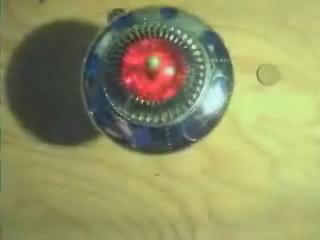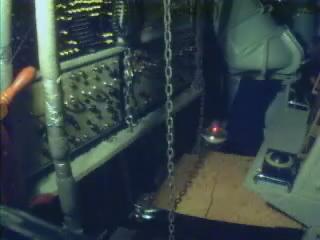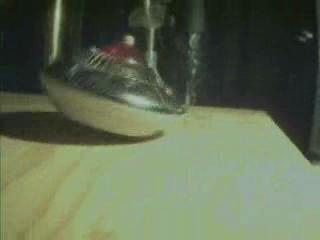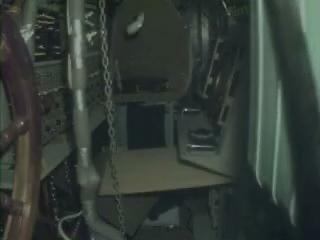|
 |
 |
 |
 |
 |
 |
| I had
been watching a program on TV about alien contact and crop
circles which was fascinating in it's own right. However, one thing
really caught my attention. In this program was a brief mention of the work by John Hutchison and showed his footage demonstrating what has become known as the 'Hutchison Effect'. This footage allegedly showed objects floating and bouncing through the air and metal objects that had mutated or melted almost like wax. Intrigued by this I tucked the name away into my memory so I could look up more information later on the Internet. It didn't take me long to find all sorts of websites about this person and his work. Amongst the first few sites I looked at were some links to a few multimedia files showing demonstrations of the effect. I eagerly downloaded them and watched. I found the links to these videos on the American Antigravity's webpage on John Hutchison. The links themselves actually download the files from the UFORC website. There are supposed to be six different files available but only four of the links worked. I have made copies of the files available for download from here for convenience. These files are the exact files I downloaded on 4-3-05 so if they differ now, the content on the website has been changed Video_1.wmv - Video_2.wmv - Video_3.wmv - Video_4.wmv |
Video Overview
|
| Analysis
Of The Videos The first obvious explanation is that the saucer is suspended on a thin string. Every time it rises it has a slight wobbling motion like an object hanging by a thread. The jerky CCW motion while on the 'landing pad' could easily be explained by magnets moving underneath the plywood causing the saucer to rotate with their erratic motion. As the saucer lifts up away from the magnets it will continue to rotate under inertia in whatever direction the magnets were moving at the time the saucer moved away from them. The string twists and like a spring wants to twist back. This can be seen in the first video with the first lift off as the saucer rises with a slow CCW rotation, slows to stop, and then reverses direction. The erratic bouncing motion can be explained by violent jerking on the suspension string. Analysis was done by using a video decompiling program to break the .wmv format videos into individual images of each frame. I then used photo editing software to enhance and examine individual frames from each video.
Analysis was done by examining every fifth frame of the first 800 frames of Video 2. Several parameters were noted for each of these frames. * The vertical position on the left edge of the image where the string goes off frame * The angle of the string * The saucer's vertical and horizontal position It was then a simple matter of graphing the data to make the correlations visible. As can be seen in the above graph, the position and angle of the string definitely correlates with the motion of the saucer. This is most evident in the first third of the graph. If the string operator had been able to pull the string perfectly without deflection the string would not have appeared to move and no correlation would have been found. The saucer being suspended by the string acts as a pendulum. The period of oscillation of a pendulum is dependent solely on the length of the string. The shorter the string, the faster the pendulum swings. As can be seen in the graph the horizontal position of the saucer begins to oscillate back and forth faster when the saucer is pulled higher in the air and slows when lowered. This is most evident in the first third of the graph. The erratic motion of the saucer towards the end of the graph is correlated with the erratic motion of the string during those frames. There are gaps in the string position and angle data because the string was being moved to quickly and was not visible in individual frames. However, the position of the saucer was evident in all frames. The Magnets The existence of magnets to help control the motion of the saucer is evidenced by the rhythmic rotation of the saucer while it is 'landed' and the much smoother rotation while in the air. This is most evident in Video 1 where the saucer spends more time on the plywood board and it's motions in the air are mostly vertical and relatively slow. Analysis of this video was also done on a frame by frame basis.  Referring to the above graph it can be seen that while the saucer is still 'landed' it's rotation is rhythmically controlled but once it rises away from the influence of the controlling magnets its rotation is steady under the influence of angular inertia. The oscillation of the saucer on the end of the string is also apparent in this graph only while the saucer is in the air and not while 'landed'. The Attachment Point The third video has the camera placed on the plywood 'landing pad' in close proximity to the saucer. Surely with the camera so close we should be able to see the string. It's not immediately obvious due to the poor quality of the imagery due to excessive compression. But just as in the previous two analysis we can find evidence of the string attached to the saucer.  Throughout the third
video it is plainly clear that
on top of the saucer is a small protuberance with a hole in it. This
knob would be the ideal place to attach the suspension string. Viewing
each individual frame one at a time showed evidence of the string
itself in a few frames. Throughout the third
video it is plainly clear that
on top of the saucer is a small protuberance with a hole in it. This
knob would be the ideal place to attach the suspension string. Viewing
each individual frame one at a time showed evidence of the string
itself in a few frames.First I took the best frames where the string was most discernible without enhancement and cropped out a small section from each frame, removed some of the compression artifacting, blew them up 500%, then made a short animation. As can be seen in the animation to the left the string is just visible above the eye of the knob and moves with the position of the saucer. 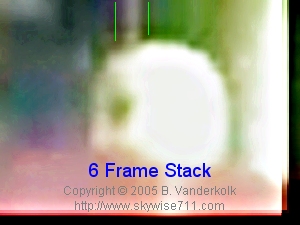 Even so, I
wanted to make it more apparent that the string exists. Borrowing a
technique from astronomy I aligned and stacked six frames on top of
each other, blending them, then used an unsharp mask to bring back some
of the detail. This stacking technique is used by astronomers so they
can take multiple short exposure images and put them together as if
they had taken one very long exposure. Even so, I
wanted to make it more apparent that the string exists. Borrowing a
technique from astronomy I aligned and stacked six frames on top of
each other, blending them, then used an unsharp mask to bring back some
of the detail. This stacking technique is used by astronomers so they
can take multiple short exposure images and put them together as if
they had taken one very long exposure.The result, to the right, really makes the strings existence stand out. The advantage of this technique is it increases the signal to noise ratio. Any random noise is different in each image and will tend to average out over the multiple frames. The signal, in this case the faint string, will just be amplified. Other Inconsistencies There are a few other problems which can be seen in these videos. The poor quality of the imagery in these media files is due to excessive compression and the small frame size. This has the benefit of hiding features that would otherwise be visible in the raw video footage from even a low quality home camera. I have to wonder if this wasn't by design. After all, who would perpetrate a hoax where the strings were clearly visible? In Video 3 there is one point where the jumping of the saucer brings it so close to the edge of the plywood landing pad that it actually tips over the side. The wise thing to have done would have been to let the saucer fall off the edge. However, the string was used to jerk the saucer back onto the plywood board for further display of its antics. Shortly thereafter the saucer does finally fall off the edge. Also, in Video 3, I have to wonder why the camera is not affected by the same energy fields that are causing the saucer to move and jump. The camera is sitting on same plywood surface and the saucer comes very close to the lens. In fact, if you watch carefully the camera is actually moved a little when the saucer bumps into it. Obviously the camera is not anchored down. Since it's not anchored, why doesn't the camera itself move around under the influence of the same energy field that is driving the motion of the toy saucer? |
| Conclusion I think it is self evident from the above analysis that the reason no one else has been able to duplicate the "Hutchison Effect" is because they forgot to attach the string! There are other videos purportedly showing different effects. However, considering the obvious fraud in these four videos, there is little reason to think they may be any more valid than these four. Considering the controversial subject matter, and the general agreement that "extraordinary claims require extraordinary proof", and that one example of said proof turned out to be a fraud, I think it's safe to say there is no "Hutchison Effect". |

